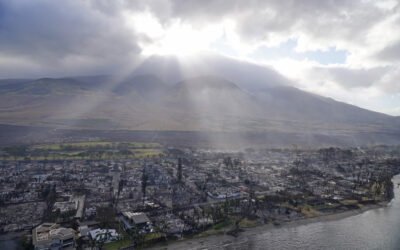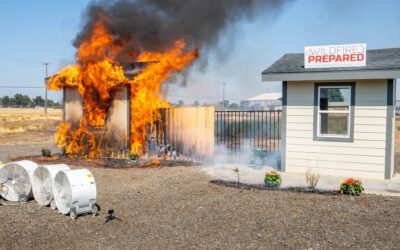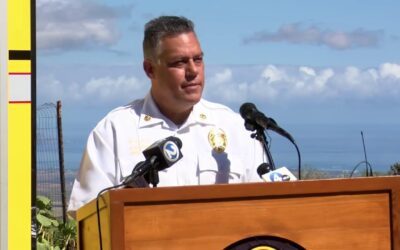By NICHOLAS K. GERANIOS Associated Press
SPOKANE, Wash. (AP) — Thousands of wildfires ignite in the U.S. each year, and each one requires firefighters to make quick decisions, often in difficult conditions like high winds and lightning.
Crews and managers must determine when to bring in aircraft, what time of day is best to battle flames, whether to evacuate residents and even if certain fires should be extinguished at all.
In the West, which sees many of the country’s largest fires, they do all this amid the backdrop of prolonged drought and other climate change-induced conditions that have made wildfires more destructive. Other challenges include a century of reflexive wildfire suppression and overgrown forests, experts say, and communities that have crept into fire-prone areas.
Russ Lane, fire operations chief for the Washington state Department of Natural Resources, explains how some key firefighting decisions are made:
WHY DO FIRE MANAGERS LET SOME WILDFIRES BURN?
Sometimes fires fit a beneficial land management goal, like when they burn in a wilderness area or national park.
Fires are part of the natural forest cycle, and “at times that’s the right approach,” said Lane, who is in his 35th season as a firefighter, much of that spent in western Oregon. He joined Washington’s natural resources agency in 2019.
Also, wildfires sometimes burn in areas where it is unsafe to put firefighters.
WHEN DO FIRE MANAGERS DEPLOY AIRCRAFT?
Planes or helicopters are used if a wildfire is burning too intensely to send in ground forces, or if aircraft are the best way to deliver water or retardant, Lane said.
“You want to hit a fire quick so it stays small,” Lane said.
The goal is to keep them from erupting into megafires. Cal Fire, California’s firefighting agency, keeps an average of 95% of blazes to 10 acres (4 hectares) or less.
But Lane said aircraft alone are usually not enough to extinguish a fire. “It takes boots on the ground.”
Aircraft also can face numerous visibility limitations when trying to make water drops on a wildfire.
HOW HAS TECHNOLOGY HELPED?
When it comes to early detection, one innovation is replacing fire lookout towers staffed by humans with cameras in remote areas, many of them in high-definition and armed with artificial intelligence to discern a smoke plume from morning fog. There are 800 such cameras scattered across California, Nevada and Oregon.
Fire managers also routinely summon military drones to fly over fires at night, using heat imaging to map their boundaries and hot spots. They can use satellite imagery to plot the course of smoke and ash.
WHAT IS THE BEST TIME OF DAY TO ATTACK A BLAZE?
Generally the heat of a summer day is not the best time to fight wildfires.
“We are pretty successful in the morning, late evening or overnight,” Lane said.
ARE WILDFIRES HARDER TO BATTLE IN TIMBER OR GRASSLANDS?
Dry lightning puts dozens of fires on the landscape, Lane said, and weather is a major factor in their spread.
Wildfires in grassland tend to grow more quickly, and are more susceptible to expanding when there are high winds, Lane said. Fires in timberlands don’t grow as fast, but they are more difficult to extinguish.
“With grass, a little rain and it goes out,” Lane said.
HOW TO SAVE HOUSES WHEN FIRES ARE CLOSE?
Lane said the building material used on a house, and the nearby vegetation, are big factors in determining if a house can be saved when fire approaches.
Houses with wooden roofs and lots of flammable vegetation around them are hardest to save. Usually a fire crew will spray water around a house to protect it.
Sometimes they will burn out the vegetation around a house to starve an approaching wildfire. If the homeowner keeps brush well away from a home prior to a fire that is a big help, Lane said.
WHERE DO FIRE NAMES COME FROM?
Usually a fire is named by the first unit of firefighters on the scene. Most of the time the name reflects a nearby geographic feature, such as a creek or valley.
California’s massive Dixie Fire, for instance, was named after the road where it started on July 14.
WHY DO FIREFIGHTERS SPEND SO MUCH TIME DIGGING LINES?
“Every fire has to have a dirt trail around it,” Lane said. “That’s to separate the fuel from the fire.”
Firefighters also get help when the flames burn toward a river, a rocky area or a road. “Separating fuel from fire is what stops them,” he said.
WHO LEADS A PARTICULAR FIREFIGHTING EFFORT?
Wildfires get one of five ratings, with Type 5 the least dangerous and Type 1 the most dangerous. More than 95% of all fires are smaller Type 4 or 5 wildfires and are quickly put out by local firefighters.
Larger fires, like the ones the Washington state Department of Natural Resources responds to, are assigned an incident commander, said Janet Pearce, agency spokeswoman.
The commander creates a set of objectives, which guides the command and general staff. An operations section chief then devises the strategy for the operational firefighting effort.
WHEN DO YOU ORDER RESIDENTS TO IMMEDIATELY EVACUATE?
Emergency managers consider fire behavior, predicted weather and the amount of time it will take to evacuate, when making the decision to order people to leave, Lane said.
They also consider the availability of shelters and the potential for harm or loss of human life.
Occasionally, an order is given to “shelter in place.” This is typically done when there is either no time to escape an oncoming fire, or it would be more hazardous to evacuate than remain in place, he said.




